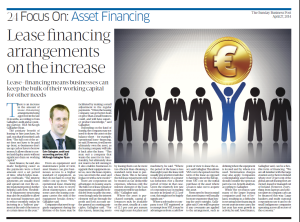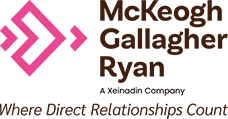The Sunday Business Post spoke to Audit Partner Eoin Gallagher about lease financing and the value and costs it represents for the SME.
Lease financing arrangements on the increase
Lease-financing means businesses can keep the bulk of their working capital for other needs
There is an increase in the amount of lease-financing arrangements being approved in the last 12 months, according to Eoin Gallagher, audit and accounting partner, HLB McKeogh Gallagher Ryan.
The primary benefit of leasing or hire purchase, he said, was that it benefited cash flow. “The full cost of the asset does not have to be paid up-front, so businesses don’t use up cash or have to borrow money. It allows them to control and deploy assets without significant drain on working capital.”
Asset finance, he said, also made budgeting easier as the payments were a fixed amount over a set period of time, which helps manage overheads. “The interest payments are usually fixed and spread out over the entire repayment period, further helping cash flow. Flexibility of repayment structuring may also be available to allow for seasonal businesses and to reduce monthly outlay by factoring in a ‘balloon’ payment at the end of the term or at certain times in the year.”
From an equipment and maintenance point of view, asset finance can give businesses access to a higher standard of equipment, as they do not have to cover the entire cost up-front. “With operational lease-financing you may not have to worry about maintenance, and in some cases the leasing company carries the risks if the equipment breaks down,” Gallagher said.
Companies that need to upgrade equipment during the lifetime of the lease may be facilitated by making a small adjustment to the regular payments. “Often the leasing company can get better deals on price than a small business could, and will have superior product knowledge,” said Gallagher.
Depending on the kind of leasing, the company may not need to show the asset on the balance sheet – for example, operational lease-financing, he said. However, it will never ultimately own the asset, as the leasing company will take it back after the lease. “This may suit a company that wants the asset for its functionality, but ultimately does not want to be left owning it. It also enables businesses to upgrade their equipment easier as, once the lease expires, you can return the asset and replace it with a new model.”
There are corporation tax advantages in leasing assets. The full cost of lease rentals or repayments can usually be deducted from taxable income, even though only the interest element will go through the profit and loss account under general accounting principles, Gallagher said. “For this reason, financing assets by leasing them can be more tax efficient than obtaining a standard-term loan to purchase them. This is because the full lease repayments will be treated as tax deductible expenses, whereas only the interest element of the loan repayment will be tax deductible,” Gallagher said.
Where the asset is purchased outright, capital allowances may be available on the asset, usually at a rate of 12.5 per cent per annum over eight years for plant and machinery, he said. “Where the period of the lease is less than eight years the lease will usually give a better result due to the availability of a greater tax deduction over a shorter period of time in that case. Given the relatively low rate of corporation tax on trading income in Ireland of 12.5 per cent, this might not be hugely significant.”
Where a sole trader or company is not VAT registered or is exempt from VAT, it may be advantageous from a cash flow point of view to lease the asset, said Gallagher. This allows VAT cost to be spread over the term of the lease as opposed to having to incur the full upfront VAT cost on the initial purchase of the asset where a loan is take out to acquire the asset.
Firms need to bear in mind that asset finance will usually be more expensive than buying the asset outright, Gallagher said. Costs will be greater if any covenants are applied to the arrangement, such as defining where the equipment is located and by whom it is used. Termination charges may also apply. Companies contemplating asset finance should consider the option as part of a cost-benefit analysis, according to Gallagher.
While the recession saw many of the larger leasing companies pull out of Ireland, resulting in a difficulty in securing lease financing in recent years in some cases, the last year has seen growth in activity, he said. Asset finance, Gallagher said, can be a flexible form of financing. “We are all familiar with the large aviation sector here in Ireland where over 50 per cent of the global aircraft leasing fleet are owned, leased or managed out of Ireland. However, everything from laptops and photocopiers to company cars can be financed this way. Large hauliers and multi-national corporations use it and so do small indigenous companies operating across all sectors of the economy.”
This article appeared in the print edition of the Sunday Business Post on April 27, 2014
